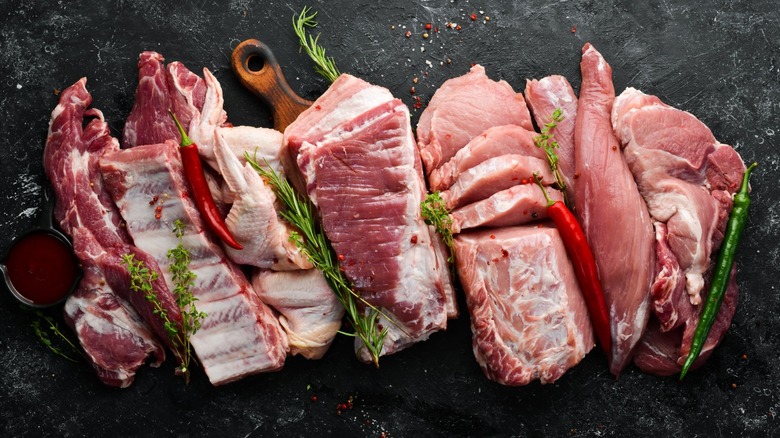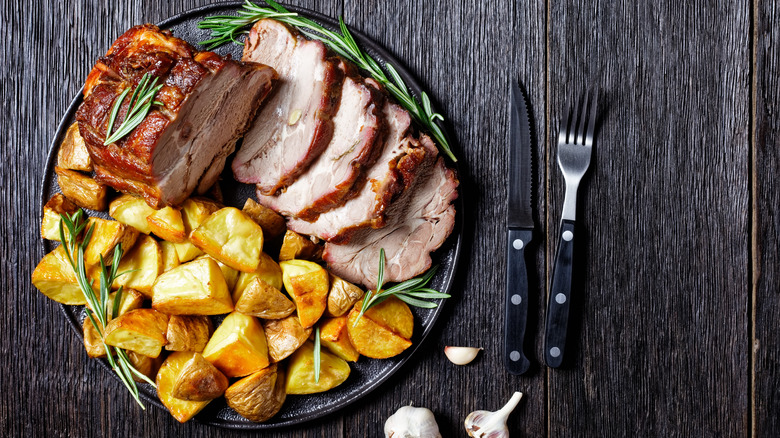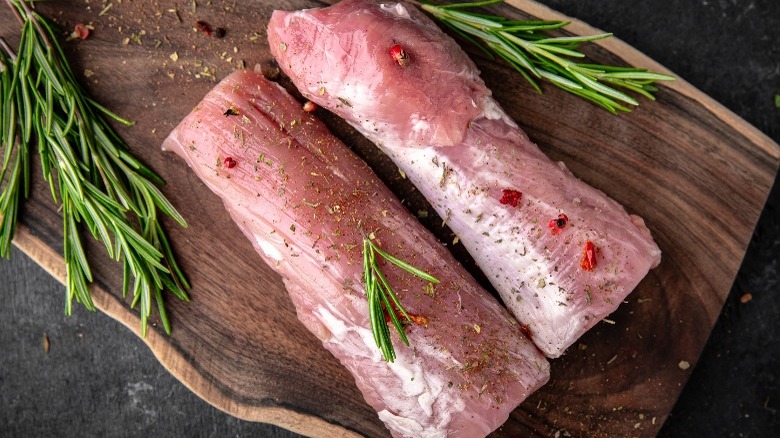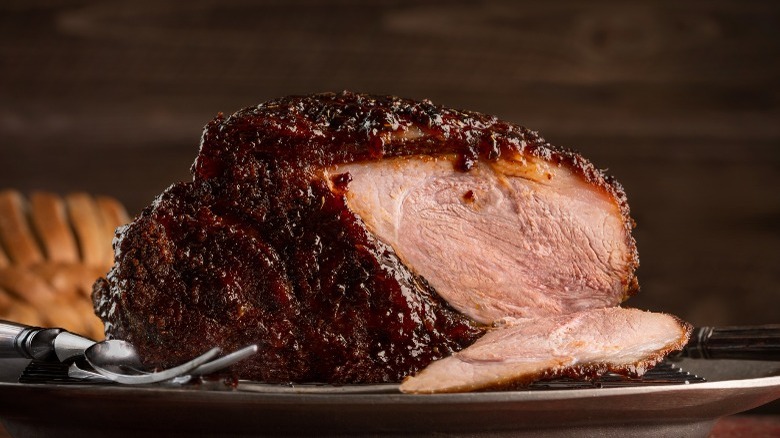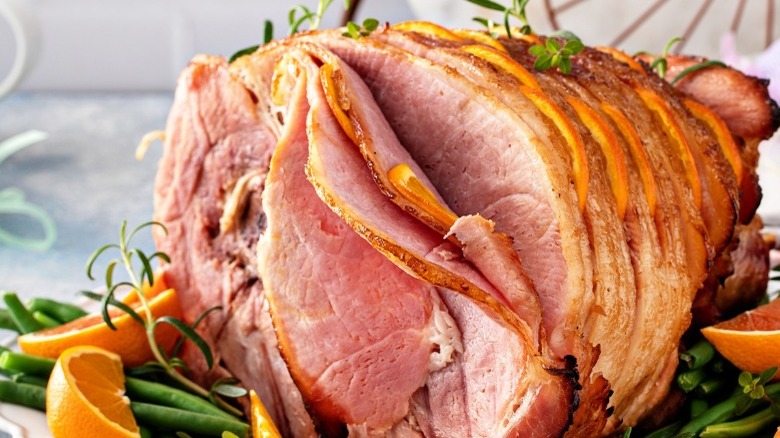The Absolute Best Cuts Of Pork To Roast
Pork is a much-beloved protein, from mouthwatering baby back ribs and tender-braised pork cheeks to the salty-sweet balance of kalua pork belly and the siren's call of crisp bacon (in just about anything). When it comes to flavor — pork is king.
For the most part, we can credit that flavor to pork's fat content. But when it comes time to roast that pig, if you don't have the right cut or cooking advice on your side, things could get a little hard to swallow. That's because while the fattiness of some cuts (like pork belly) can insulate the meat and infuse it with moisture, giving them their juicy, tasty bite, others can be quite lean and more temperamental in the dry heat of the oven. And even with the right piece, there are still a lot of ways you can go wrong in cooking up your favorite cut of pork. However, when equipped with a good cut and the right approach, you'll find that even some of the leanest cuts can come out tender and flavorsome.
Pork loin
Pork loin roast and pork tenderloin are often confused for one another, but they are different cuts with different flavor profiles and even different hues. While both come from the same overall quadrant of the pig, their exact placement leaves them with distinctly different qualities and optimum roasting conditions. Both are lean with a good flavor and texture when cooked correctly, though pork loin roasts are not quite as tender as tenderloin (as the name implies). This means when it comes time to roast pork loin, lower and slower will help you tease out its tenderness.
You can purchase pork loin on the bone (called a crown roast) or boneless, and it can even be cut down to make chops. Light in color and mild in flavor, this cut is wider and larger (3 to 5 pounds per roast) than its tenderloin counterpart (typically about 1 and ½ pounds). Cut from the back of the pig between the shoulder and back legs, the pork loin comes with a cap of fat running along its top. Taste of Home recommends this bigger cut for its ability to "feed a crowd," and advises using leftovers for tasty pork sandwiches. If you can get your hands on a skin-on pork loin roast, British celebrity chef Jamie Oliver suggests keeping it on to seal in moisture and get crispy cracklings. Otherwise, you can brine it, rub it, or toss the pork loin in your favorite marinade before roasting.
Tenderloin
Pork tenderloin, on the other hand, is a longer, thinner, and leaner cut, darker in color than pork loin, and has little to no fat on it. In fact, it's as lean as skinless chicken breast, according to the National Pork Board. And while pork tenderloin can make for a really delicious low-prep meal in no time, it's important to remember to remove the sinewy silver skin and add a bit of oil to the tenderloin's exterior, rubbing it over the entire cut to seal in moisture and flavor before it hits the oven.
Because roasting temps are higher for pork tenderloin, it cooks much quicker — leave it in too long and you'll be left with a dry, flat result. Cook it at 425 degrees for 20 to 25 minutes depending on its size and until it has reached an internal temperature of 145 degrees Fahrenheit. It should be succulent and lightly pink inside. But remember, if you like your tenderloin with a nicely browned crust, be sure to give it a quick sear in a hot cast iron skillet on all sides before popping it in the oven to finish.
Pork shoulder
Pork shoulder roasts come in bone-in or boneless varieties (though they are most often sold boneless). These fat-rich cuts are a dream for roasting and provide a lot of bang for your budget. According to The Cook's Illustrated Meat Book, shoulder roasts are often referred to as pork butt, Boston butt roast, shoulder arm picnic, picnic shoulder, fresh picnic, and picnic roast. These large cuts run anywhere from 4 to 10 pounds in weight (depending on bone-in or boneless).
Thanks to their naturally tough chew, pork shoulder is best cooked low and slow to allow their moist-making fat to render, melting down to penetrate the meat, and leaving you with a flavorful and tender cut at a great value. It's also a good idea to remember to let your pork shoulder sit on the counter for 20 to 30 minutes to allow it to take the chill off and warm to room temperature. This will allow more even cooking throughout. The National Board of Pork recommends cooking this cut to an internal temperature of 170 degrees Fahrenheit to make it fall-apart tender. This is the cut best used for pulled pork as its ample connective tissue allows it to shred down nicely.
Leg (or hams)
Pork legs are also known as the hams, which come from the hind legs of the pig and are ideal for roasting. The best cuts from this part of the pig include fresh or uncured ham, and spiral-sliced bone-in half ham (or spiral-cut ham). When it comes to ham — fresh uncured or spiral cut — you have two parts: the shank end and the sirloin. According to The Cook's Illustrated Meat Book, while the sirloin end's bone structure makes it harder to carve, it is rich in flavor. Still, they recommend the shank end, which they note is covered in a thick layer of skin and fat and is best suited for brining.
Spiral-sliced bone-in half ham is the wet-cured version of these hams, packed in its own natural juices, with no water added. Just as with fresh ham, the shank end is best (and bone-in brings the most flavor). If you're unsure if your cut is shank end or sirloin, just be sure to look for the telltale tapering on one end that lets you know its shank. The draw here, of course (besides the fact that it is ham), is its ease of slicing.
Roasting pork: A new internal temperature
Before you head to the market or butcher shop to pick up the cut of your choice, it's a good idea to review the pork roasting guidelines to ensure a safe and succulent result. Years ago, the USDA recommended that pork be roasted to an interior temperature of 160 degrees Fahrenheit to kill off any Trichinella (aka trichinellosis or trichinosis) that may have infected the meat. That advice has since been changed to 145 degrees Fahrenheit with an additional 3 minute resting time, due to updated science that shows the parasite is actually killed off at 137 degrees Fahrenheit. The CDC reports that improvements by the pork industry in the raising of livestock and heightened public awareness of the danger of eating raw or undercooked pork have helped to significantly lower the risk of trichinellosis over the last few decades.
No matter what cut you choose, it's important to remember not to cook your pork straight from the fridge (you'll get more even cooking if you let it sit for 20 to 30 minutes on the counter first) and to let your roasted fresh-from-the-oven pork rest before slicing it. This will lock in the moisture and help you avoid the most cardinal of all sins when it comes to cooking pork — letting the juices all drain away by slicing too early.
